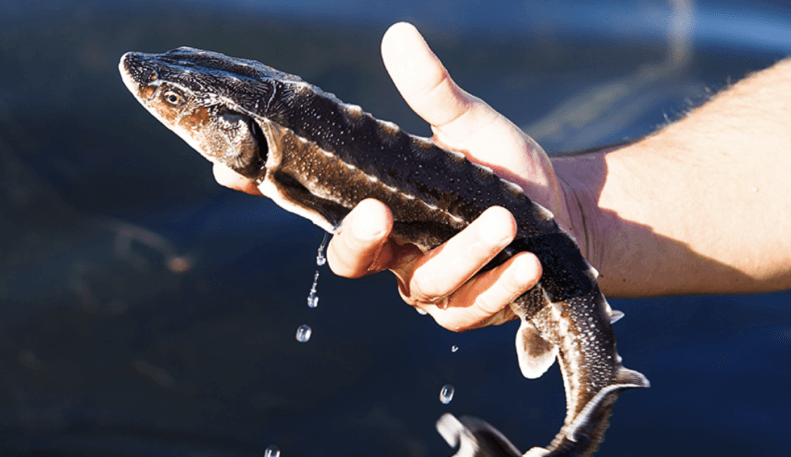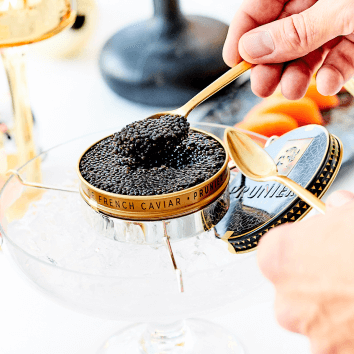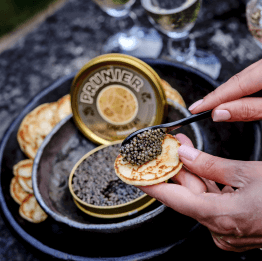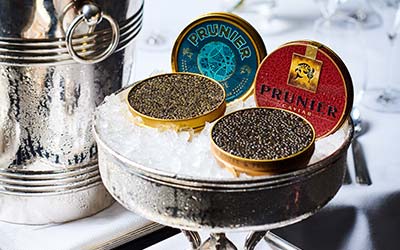Caviar is undoubtedly an exceptional delicacy, with a unique palette of flavors and aromatic complexity.
Many people enjoy it, for special occasions and occasions of all kinds. Yet caviar can also be an intimidating product, with so many varieties and subtleties to choose from.
So choosing the right caviar is not only the first step, but also the promise of a great tasting experience.
What should you choose? What criteria should be observed to avoid making a mistake?
And, most importantly: which caviar is right for you?
Discover our 5 recommendations for choosing your caviar with peace of mind.
1. Understand the different caviars and their varieties:
The range of caviars on offer today is vast and therefore more complex to understand. Beluga, Osciètre, Baerii, Sevruga... are all well-known caviar choices that are sometimes difficult to differentiate.

Here are a few facts about the main species:
- Caviar Osciètre : With its smaller, firmer grains, osciètre caviar is also recognizable by the deep black to golden-brown color palette of its eggs. Osciètre caviar keeps well: its maturation allows it to improve with age. It is also a caviar characterized by a frank attack, a palette of rare flavors and aromatic peaks that express themselves throughout the tasting experience: all qualities that make it one of the caviars preferred by connoisseurs.
- Caviar Baeri : the French caviar par excellence, present in the Gironde estuary for decades. It is characterized by its frank notes and exceptional finesse on the palate. It's a caviar that everyone agrees on, from neophytes to experienced connoisseurs. To reveal the full range of its aromatic potential, we've divided our Baeri caviar into 4 recipes, each with a more or less pronounced iodine intensity.
- Beluga Caviar : from the Huso huso species, this caviar is particularly sought-after for the size of its particularly large grains. Their color varies from dark to light gray, and their membrane is particularly thin.
- Sevruga Caviar : more widespread, Sevruga is a caviar that stands out for its fine grains and iodized taste. Many appreciate its accessibility and particularly pronounced taste. It is also recognized by its dark gray hue.
2. Paying attention to the origin:
Knowing the origin of the caviar you choose is, of course, essential.
Sturgeon are bred for a minimum of 6-7 years, and up to 15 years before their precious seeds are harvested. Each sturgeon is therefore imprinted with its merroir, the water in which it grew up and the food it received.
Its origin has a direct influence on its taste and the notes it reveals on the palate beyond the more or less restrictive regulatory standards in force in different countries. French caviar, for example, is characterized by notes of nuts, somewhere between almond and walnut. As summarized by our Prunier caviar producer (World Expert in French caviar and founder of Prunier Manufacture), Laurent Sabeau : « caviar must reveal its local typicity because it is the pure expression of its terroir”.

Moreover, the recipe for caviar is simple: sturgeon eggs, salt and centuries of know-how.
All factors that lead us to take an interest in where and how sturgeon are farmed. How are sturgeon treated and fed? Are they farmed responsibly?
Caviar Prunier produces all its caviar in the south of France, in Aquitaine. Our responsible farm was one of the first established in France. With over 150 years' experience, we now produce our own caviar and control the entire production chain.
3. Observe its appearance and texture:
Let's get to tasting.A quality caviar is distinguished above all by its beautiful, shiny appearance. You'll also appreciate the rather firm texture of its grains and their uniform color.

4. Enjoy the flavours:
Beyond the typicality of its merroir, a good caviar can be recognized by its iodine intensity, buttery notes and, in the case of French caviars, hints of nuts. It will also reveal a progressive, fine and unique length on the palate, making every tasting experience exceptional.
As a producer, Caviar Prunier can therefore offer you variations of caviar with a consistent, harmonious taste from one year to the next.
To enjoy its finest aromas, start tasting your caviar pure. Use a small mother-of-pearl-spoon, or any other natural material, to avoid altering the taste.

5. Check the freshness:
Did you know? Caviar is matured before being sold. It develops its best aromas in contact with salt for several months.
While French caviar should usually be consumed within the year, its complexity can be appreciated as early as 3 to 4 months for Baeri caviar and around 6 months for Osciètre caviar.
Caviar, on the other hand, must be kept in a cool place, and the cold chain must be respected until it is tasted. Be sure to check the conditions of delivery and tasting.
Do not consume caviar from a tin opened more than 24 hours after delivery.

Good caviar is of course a matter of taste, but it's also important to have some information about its provenance and production conditions. Choose a caviar house known for its expertise and reliability.
From selection to tasting, find out more about our tips for the art of caviar tasting.
Not sure which caviar to choose? Visit our boutique in Paris, place de la Madeleine, to taste our caviars and choose the one that's right for you.

